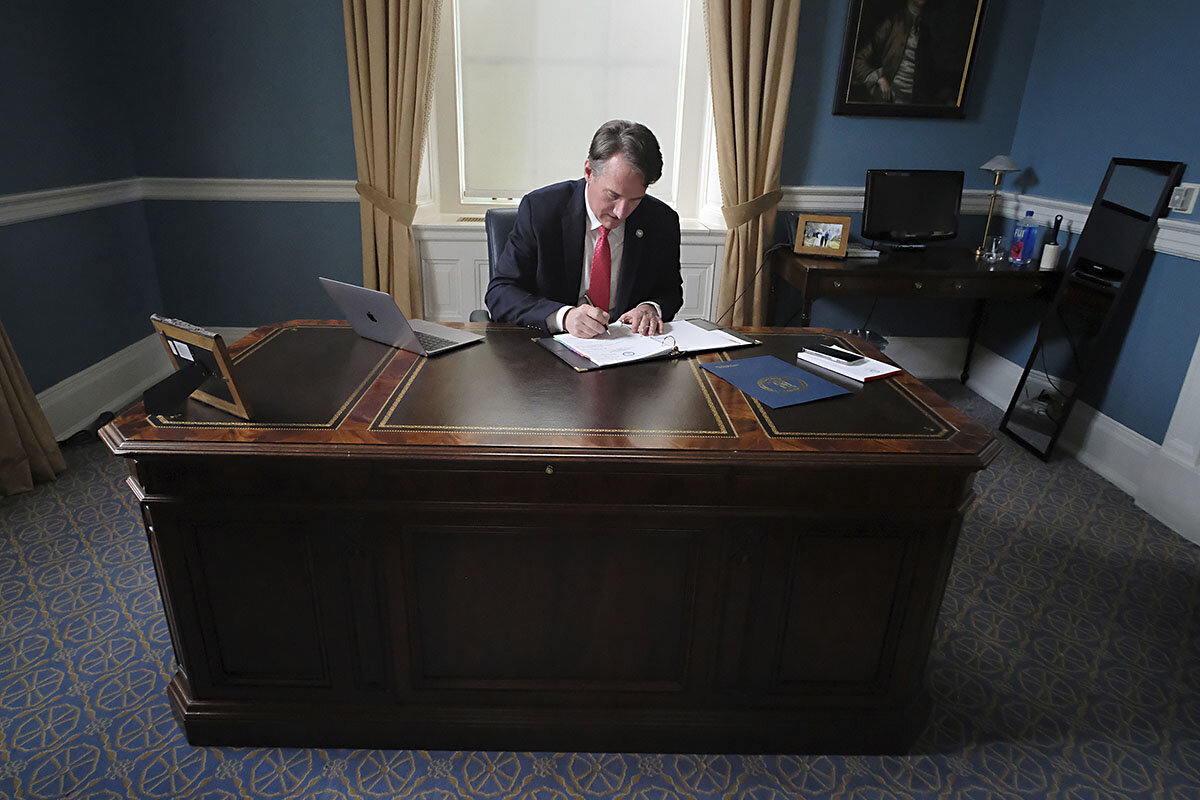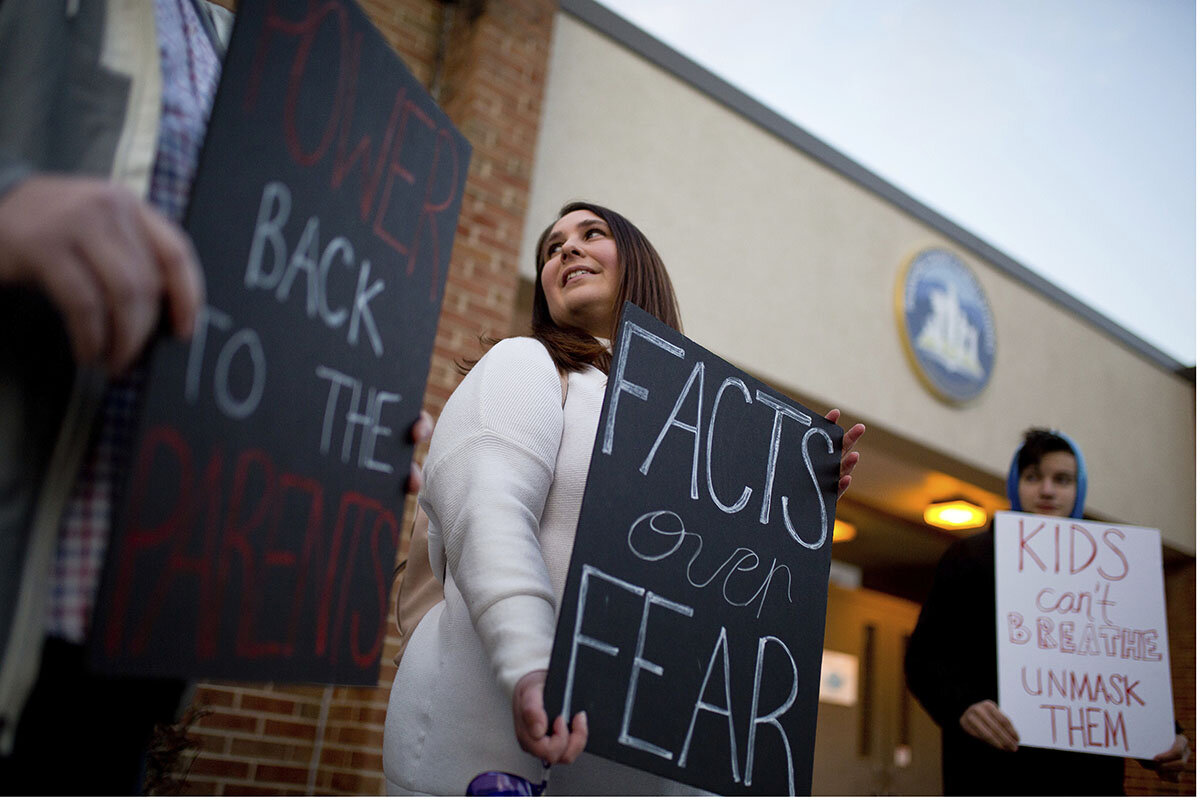‘Democrats woke a sleeping giant’: Why parents say they’ve had enough
Loading...
Jennifer Reesman has always been a proud Democrat. A single mother who lives in one of the nation’s bluest counties, she says some of her favorite items of clothing include T-shirts from both Hillary Rodham Clinton’s and Sen. Elizabeth Warren’s presidential campaigns.
But as America enters its third year of the COVID-19 pandemic, Ms. Reesman is actively organizing to vote her local and state Democratic leaders out of office.
“I can’t look my kid in the eye and say I care about your education and vote for the Democrats right now,” says Ms. Reesman, a pediatric neuropsychologist from Rockville, Maryland. “I cannot believe that this is where we are – but it feels personal, and it feels painful.”
Why We Wrote This
Pandemic fatigue is hitting Americans hard, particularly parents. They want to see their children happy, healthy, and in school, and are growing increasingly weary of “never-ending” COVID-19 restrictions.
In 2020, Democrats won the White House and Senate in part by pitching themselves as the party that would take the pandemic seriously and get it under control. More than 90% of Democratic voters thought precautions like avoiding group gatherings and closing in-person schooling were necessary in the early months of the pandemic, according to Pew Research. In crucial swing states, a majority of voters said in exit polling that containing the virus was more important than rebuilding the economy.
But a little over a year later, America is in a very different place. Vaccines are widely available, numerous studies have confirmed the virus poses little risk to children, and public health officials have characterized omicron as less virulent than previous variants. And a growing number of Democratic voters like Ms. Reesman are voicing frustration over the mounting toll of pandemic protocols – particularly those affecting kids and their education.
In cities where stadiums are packed with screaming sports fans and bars are fully open, many schools are continuing to impose mask mandates, separate children at lunch, and limit their extracurricular activities. Up until a recent change in guidance from the Centers for Disease Control and Prevention, schoolchildren often had to quarantine for 10 days whenever anyone in their class tested positive, causing a steady stream of disruptions.
With Democrats already facing head winds going into November’s midterm elections, political strategists say being seen as the party of “never-ending” COVID-19 restrictions could pose a significant political liability. An early warning sign came with last November’s gubernatorial election in Virginia, where Republican Glenn Youngkin won in part by tapping into parental frustration. Post-election polling showed that education was the dominant issue for Biden-Youngkin voters, with almost three-quarters of education-minded voters supporting Mr. Youngkin.
Notably, both Virginia and New Jersey – an even bluer state where the Democratic governor barely eked out reelection in November – were in the bottom 10 states for in-person schooling during the 2020-2021 school year. Maryland, where Ms. Reesman lives, was ranked 47th. She says that at this point, Democratic officials ignore pandemic fatigue at their peril.
“We are a family that has done everything right,” says Ms. Reesman, noting that she is boosted, her daughter is vaccinated, and they have conscientiously worn their masks when out in public. “There is just no end of restrictions in sight, and no one seems to give a damn about it. I think Democrats have really underestimated what this did to families – and our level of anger.”
“Things don’t feel back to normal”
At a recent press conference, President Joe Biden acknowledged that “there’s a lot of frustration and fatigue in this country” due to the pandemic, but insisted the nation is in a better place than a year ago. He noted that last spring’s $1.9 trillion American Rescue Plan provided $130 billion to keep students and educators safe and schools open.
Many school districts “spent this money very well,” the president said, although “unfortunately, some haven’t.” When asked directly if he thought school closures could be a potent issue for Republicans in the upcoming midterm elections, Mr. Biden admitted, “It could be.”
“There is frustration, because people wanted to see a return to normalcy under Biden,” says Aliza Astrow, an analyst with the centrist think tank Third Way. “That’s what he promised and what people expected – but things don’t feel back to normal.”
Recent polls show a widening divide among Democrats when it comes to COVID-19 restrictions. When asked in a Monmouth University poll if they agreed with the statement “It’s time we accept that COVID is here to stay and we just need to get on with our lives,” almost 90% of Republicans and more than 70% of independents said yes. Democrats, however, were almost evenly split – with 47% agreeing and 51% disagreeing.
“It shows a fracture” in the Democratic Party, says Jason Roe, a GOP strategist and former executive director of the Michigan Republican Party. And internal divisions are not something a party wants heading into an election – particularly as it becomes harder and harder to please both camps.
Several Democratic governors, such as Colorado Gov. Jared Polis, Pennsylvania Gov. Tom Wolf, and even Michigan Gov. Gretchen Whitmer, who had imposed some of the toughest restrictions in the country early on in the pandemic, have lately been emphasizing the need to “move on.”
But the delay in getting there, and the continued push for restrictions by other members of the party’s base, may be enough to fuel a red wave next fall. In Michigan, Mr. Roe says county party chairs are seeing “swelling participation” at local meetings with a new kind of attendee: parents.
“I think the Democrats woke a sleeping giant,” says Mr. Roe. “You are reaching a point where people on the left, who maybe were more collectivist about our responsibility, are done with it. They want their kids to be in a normal situation.”
Disrupted schooling
While nearly all U.S. public schools have been operating in person since the fall, periodic closures and other disruptions have persisted.
According to Burbio, a data service that tracks school pandemic-related disruptions, more than 7,450 public schools were not open for in-person learning the second week back from winter break. Almost 5,000 were closed the following week. In Maryland, 11 Montgomery County schools went virtual for two weeks in January after more than 5% of staff and students tested positive – a threshold the district has since abandoned after a public backlash.
Some of the disruptions have been the result of pandemic-induced staffing shortages as teachers, bus drivers, and other staff have called out sick. Other districts were forced to close due to protesting teachers unions – sometimes pitting Democratic officials against a loyal component of their voter base. Students in Chicago missed five days of school last month when the Chicago Teachers’ Union held a strike after Democratic Mayor Lori Lightfoot opposed its demand to revert to virtual schooling.
It’s the one issue that comes up at campaign events “without exception,” says David Blair, one of four Democratic candidates running for Montgomery County executive.
“The pendulum has really swung from ‘Let’s be safe and cautious; let’s keep everyone home,’ to ‘Why don’t we have enough substitute teachers, masks, and testing? These kids should be in school,’” says Mr. Blair.
In some Democratic strongholds, school masking also seems to be a growing point of contention. In Virginia, where Governor Youngkin recently issued a ban on mask mandates, seven school districts are challenging the ban in court. In Fairfax County, which voted for Mr. Biden by a margin of 40 percentage points, some 4,000 people logged into a virtual town hall in which the school district explained its decision to join the lawsuit. And while it was unclear how many attendees were in favor and how many opposed, almost all who spoke testified against school restrictions “going further” than they needed to.
Maryland gubernatorial candidate John King Jr., who was secretary of education under President Barack Obama, says Democrats understand the importance of in-person education – and care deeply about children’s well-being – but have often faced difficult choices due to the unpredictable nature of the virus.
“We should do everything possible to keep schools open safely, but acknowledge that sometimes, particularly staffing challenges make it necessary for schools to go virtual,” says Mr. King, a Montgomery public school parent himself.
He says officials need to express more empathy about what the past two years have been like for parents: “It’s really important for leaders to acknowledge how hard it’s been.” To help children make up for lost learning, he is pushing for more tutoring programs. He’s also advocating for more testing, a vaccine passport system for the state, and free KN95 or N95 masks for all students – tools he believes will help schools stay open and keep students safe.
Still, some Marylanders say that at this stage in the pandemic, they want fewer COVID-19 measures, not more.
Lori Trent, an independent voter from Silver Spring in Montgomery County, voted for Mr. Biden but says she’s disappointed with the president’s term thus far. A mother who works in health care IT sales, she wishes Mr. Biden had spent less time focusing on “multibillion-dollar bills for child care” through his Build Back Better legislation and instead just ensured all public schools stayed open – the most basic form of child care for many families.
“The Democratic Party is saying, ‘We are for families; we are for the working class,’ but at the same time they are also saying, ‘We are going to close down schools – so we’re not really,’” says Ms. Trent, who sent her high school son to live with her sister in Arizona last year so he could attend school in person.
“At some point, Democrats need to drop it,” she says. “It is 2022.”
Note: An earlier version of this story incorrectly stated that more than 7,450 public school districts were closed the second week after winter break. It was more than 7,450 public schools.








